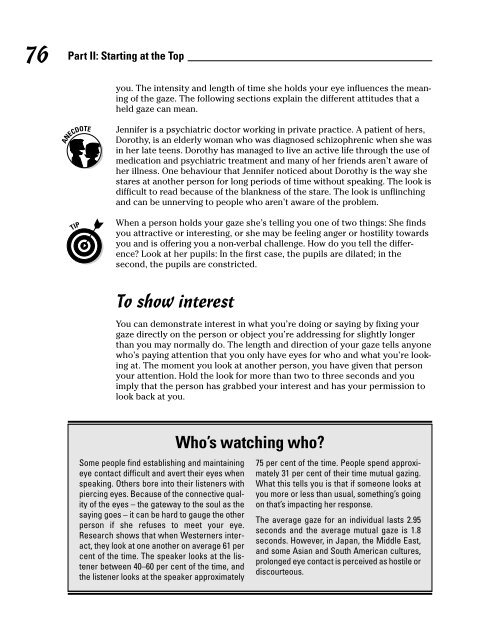Reading Body Language
Reading Body Language
Reading Body Language
Create successful ePaper yourself
Turn your PDF publications into a flip-book with our unique Google optimized e-Paper software.
76<br />
Part II: Starting at the Top<br />
you. The intensity and length of time she holds your eye influences the meaning<br />
of the gaze. The following sections explain the different attitudes that a<br />
held gaze can mean.<br />
Jennifer is a psychiatric doctor working in private practice. A patient of hers,<br />
Dorothy, is an elderly woman who was diagnosed schizophrenic when she was<br />
in her late teens. Dorothy has managed to live an active life through the use of<br />
medication and psychiatric treatment and many of her friends aren’t aware of<br />
her illness. One behaviour that Jennifer noticed about Dorothy is the way she<br />
stares at another person for long periods of time without speaking. The look is<br />
difficult to read because of the blankness of the stare. The look is unflinching<br />
and can be unnerving to people who aren’t aware of the problem.<br />
When a person holds your gaze she’s telling you one of two things: She finds<br />
you attractive or interesting, or she may be feeling anger or hostility towards<br />
you and is offering you a non-verbal challenge. How do you tell the difference?<br />
Look at her pupils: In the first case, the pupils are dilated; in the<br />
second, the pupils are constricted.<br />
To show interest<br />
You can demonstrate interest in what you’re doing or saying by fixing your<br />
gaze directly on the person or object you’re addressing for slightly longer<br />
than you may normally do. The length and direction of your gaze tells anyone<br />
who’s paying attention that you only have eyes for who and what you’re looking<br />
at. The moment you look at another person, you have given that person<br />
your attention. Hold the look for more than two to three seconds and you<br />
imply that the person has grabbed your interest and has your permission to<br />
look back at you.<br />
Some people find establishing and maintaining<br />
eye contact difficult and avert their eyes when<br />
speaking. Others bore into their listeners with<br />
piercing eyes. Because of the connective quality<br />
of the eyes – the gateway to the soul as the<br />
saying goes – it can be hard to gauge the other<br />
person if she refuses to meet your eye.<br />
Research shows that when Westerners interact,<br />
they look at one another on average 61 per<br />
cent of the time. The speaker looks at the listener<br />
between 40–60 per cent of the time, and<br />
the listener looks at the speaker approximately<br />
Who’s watching who?<br />
75 per cent of the time. People spend approximately<br />
31 per cent of their time mutual gazing.<br />
What this tells you is that if someone looks at<br />
you more or less than usual, something’s going<br />
on that’s impacting her response.<br />
The average gaze for an individual lasts 2.95<br />
seconds and the average mutual gaze is 1.8<br />
seconds. However, in Japan, the Middle East,<br />
and some Asian and South American cultures,<br />
prolonged eye contact is perceived as hostile or<br />
discourteous.


